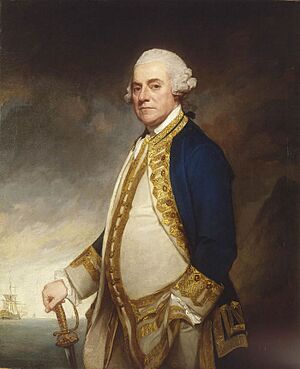Charles Hardy facts for kids
Quick facts for kids
Sir Charles Hardy
|
|
|---|---|

Hardy, painted by George Romney in 1780
|
|
| Born | c. 1714 |
| Died | 18 May 1780 |
| Allegiance | |
| Service/ |
|
| Years of service | 1731–1780 |
| Rank | Admiral of the White |
| Commands held |
|
Sir Charles Hardy (born around 1714, died May 18, 1780) was an important officer in the Royal Navy, which is the British navy. He was also a politician who served in the House of Commons, a part of the British government, from 1764 to 1780. From 1755 to 1757, he was the governor of the British colony of New York.
Contents
Charles Hardy was born in Portsmouth, England. His father, also named Charles Hardy, was a Vice-Admiral in the Royal Navy. Young Charles joined the Royal Navy as a volunteer in 1731.
He became a captain in the Royal Navy on August 10, 1741, when he was about 27 years old. His first command was a ship called HMS Rye. This ship had 24 guns. From 1742 to 1744, he was stationed off the coast of the British Carolinas.
In 1744, he was chosen to be the governor of the British colony of Newfoundland. However, there is no record that he actually visited Newfoundland during his time as governor. In 1745, he took command of another ship, HMS Torrington. He helped protect a group of ships that brought more soldiers from Gibraltar to the fortress of Louisbourg. This fortress had just been captured.
In 1755, he was made a knight, which means he received the title "Sir." He then served as the governor of the Colony of New York from 1755 to 1757. During this time, he was also promoted to Rear-Admiral of the Blue in the navy.
Fighting in the Seven Years' War
The Seven Years' War was a big global conflict. In 1757, Sir Charles Hardy helped escort an army from New York to Halifax. They planned to attack Louisbourg, but the attack was called off. This was because a strong French fleet was defending Louisbourg.
The next year, in 1758, Hardy was second in command under Admiral Edward Boscawen. They successfully captured Louisbourg during the Siege of Louisbourg.
Later that year, he and General James Wolfe attacked French outposts. These were located around the mouth of the St. Lawrence River. They destroyed all the French fishing stations along the northern shores of what is now New Brunswick. They also destroyed stations along the Gaspé Peninsula.
In 1759, he also took part in a major naval victory. This was the Battle of Quiberon Bay, led by Admiral Hawke.
After his active service, Hardy became the governor of Greenwich Hospital, London from 1771 to 1780. This hospital cared for retired sailors. In 1778, he was promoted to Admiral of the White. In 1779, he became the Commander-in-Chief of the Channel Fleet. This was a very important position. He stayed in this role until he died in May 1780.
Serving in Parliament
Sir Charles Hardy was also a Member of Parliament (MP). An MP is someone who represents a specific area in the country's government. He represented Rochester from 1764 to 1768. Then, he represented Plymouth from 1771 until his death in 1780.
Family Life
In 1749, Sir Charles Hardy married Mary Tate. Sadly, she passed away the next year. She left her home, Delapré Abbey, to him. He later sold this property in 1764.
After Mary's death, he married Catharine Stanyan. Through Catharine, he inherited an estate in Oxfordshire. They had three sons and two daughters together. Sir Charles Hardy died at Spithead. He left money to his children and his estate to his eldest son, Temple Hardy. By the time Catharine died in 1801, only Temple was still alive among their sons.
Sir Charles Hardy's brother, Josiah, was also a notable person. He was a merchant and served as the governor of New Jersey from 1761 to 1763.
See also
- Governors of Newfoundland
- List of people of Newfoundland and Labrador

